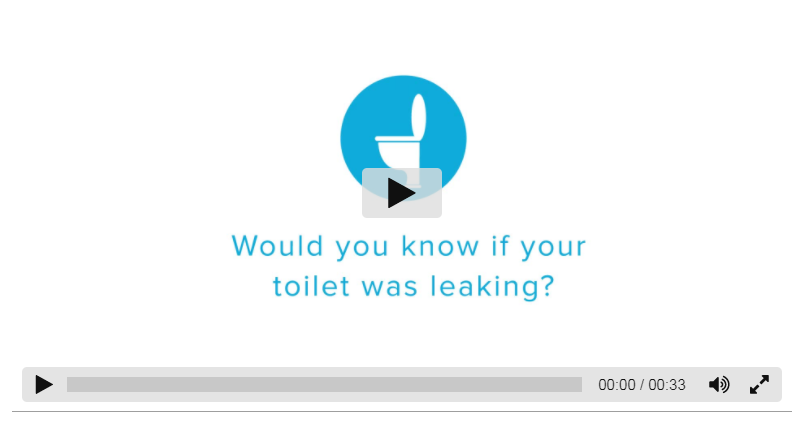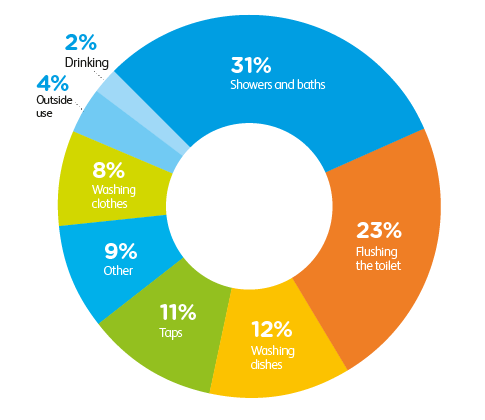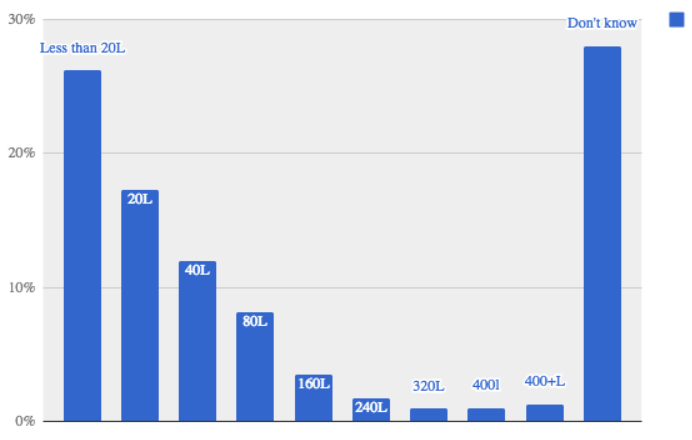
Leaky Loos
Posted on: November 2017Alice Hill, Thames Water

Alice Hill is a water efficiency project coordinator at Thames Water
What is a leaky loo?
A leaky loo doesn’t sound very nice. Is it foul water leaking? Where is leaking, onto the floor? Luckily that’s not what we are talking about but ‘leaky loos’ are easily misunderstood. So just to clarify, in this blog we are talking about toilets leaking clean water from the cistern into the bowl, often just a barely visible trickle down the toilet pan causing some ripples in the bowl water.
We have tried to make it as easy as possible for you to see what a leaky loo looks like, by filming one of our own. This video is of a toilet with a leak wastage 600 litres a day, the equivalent of 7.5 average baths. A leak that size would add around £445 a year to a metered water bill.i)

Luckily not all leaky loos are wasting this much water. Here is how to check if your loo is leaking:
If you can hear a flow of water when the toilet hasn’t been flushed or can see a slight but constant trickle at the back of the toilet pan, you may have a leaky loo.
- Wait until 30 minutes after the last flush then wipe the back of the pan dry with toilet tissue.
- Place a new, dry sheet of toilet tissue across the back of the pan. Leave it in place for up to three hours without using the toilet (it might be best to do this overnight).
- If the paper is wet or torn in the morning, you know you have a leaky loo.
Thames Water have been visiting lots of homes around London giving advice about water efficiency, installing water efficient devices and finding and fixing leaky loos. We have found leaky loos in around 5% of the more than 100,000 homes we have visited and carried out water efficiency visits and internal leak checks for.
Why are all these toilets leaking?
As Peter Curtain pointed out in his recent blog, Flushing the toilet. How it all started and where are we now? , almost all toilets used the siphon flush invented by Thomas Crapper in 1880 until the relatively recent introduction of flush valves alongside dual flush toilets in the 1990’s.
Dual flush toilets are a great way to save water and have significantly reduced the amount of water used for toilet flushing. In fact toilet flushing has been overtaken by showering as the highest using water consumption activity in the average home (figure 1).

Figure 1. Current average water consumption
But this water saving has come at a price which we are now discovering is a very large price in water ‘wastage’ terms. Almost all (between 80-90%) of the leaking toilets we identify are valve toilets. Peter goes into detail about why these toilets are more prone to leaking, but I would like to describe the scale of water being wasted by these leaks.
If we assume:
- 5% of households have a leaky toilet (a figure based on around 100,000 leaky loo checks carried out by Thames Water over the last 2 years)
- That each ones wastes 200 litres a day (A Water Industry Collaborative Fund Project carried out in 2015 found the average leaky loo wastes 215 litres per day)
- and that there are 27.2 million households in the UK (Office for National Statistics, 2017)
- Then our leaky loos are wasting 272 million litres of water per day. That’s almost 3 and a half thousand bathtubs of water every day wasted due to leaking toilets.
Another way of describing this amount of water is enough to supply 816,817 new homes ii). Given the pressure on water resources and the need for new homes in the UK and specifically in the South East, this is a huge driver to ensure we are doing everything we can do find and fix these leaks and ensure that new toilets installed are not likely to develop leaks in the future.
Save Water South East commissioned YouGov to carry out a survey on public perceptions of leaky loos to help get a real understanding of what people believed and understood about leaking toilets.
They found that the volume of water waste by a leaky toilet is vastly under estimated. Figure 2 shows that the majority of respondents either thought a leaky loo would waste less than 20 litres per day or didn’t know how much water would be wasted.

Figure 2. How much water (in litres) people surveyed believed a leaking toilet leaks in 24 hours
The survey also found that 28% of people with a leaky loo identified that it was leaking because they could hear it. Leaky loos generally have to be exceeding 600 litres per day before the sound is audible.
Given how difficult it is to identify leaky loos and the lack of public awareness of them, there is a driver to ensure that new toilets being sold and installed do not leak and are not prone to developing leaks. Waterwise’s Water Efficiency Strategy for the UK recommends that we ‘regulate to prevent the sale and use of leaky loos in the UK’ and are working with water companies, government, regulators and the bathroom manufactures association to progress this.
What can we do about it?
The simplest way to do this is to stop installing mechanical valve flush toilets and switch to WC siphon based dual flush systems. Siphon based systems, due to their airlock, are far less prone to leaking. There is not currently a push button dual flush WC siphon for sale in the UK but development of one would support the battle to rid the UK of leaky loos.
We have also started to observe a new correlation between leaking toilets and homes that have recently removed their cold water storage cistern (water tank) and switched to direct mains fed water in their bathroom. Is this change in set up and increase in bathroom water pressure leading to more leaky loos?
Cath Hassell’s 2015 blog ‘Leaky loos, a cool alliterative title for a serious problem’, also touches on this and she suspects that if a cold water storage cistern is removed and the supply switched to mains high pressure it will require a ball valve seating with a smaller orifice. If it is not changed then the ball valve will let by and this will manifest as a leaky loo. Perhaps a topic for another blog….
i) If you were paying for your water though a meter and your water was supplied by Thames Water (£2.08 per m3, 2017/18). Water costs vary throughout the UK, and Thames Water has one of the cheapest prices per m3, so the cost could be significantly higher.
ii) Assuming the average household in the UK uses 333 litres of water per day



